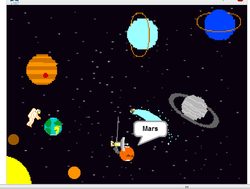
Recently I've been taking a Year 5 class for their computer lessons. They had been studying the solar system in science and I was asked to help them create a database with information about the planets.
This we did, using a database program designed for primary schools. Took us a couple of lessons. One to make the database form and then another to populate the records with information about each planet, including a picture of the relevant planet. This was okay I thought. They certainly put some thought into the fields needed and then a lot of effort went into getting the information.
But then I started looking at them. They all looked pretty much the same. Some had better spelling then others. Some had the fields neatly lined up, whereas others were a bit wonky. But all pretty much... the same. And then I started to think. Where was the computer science in this? Where was the creativity? Where was the art? Had they solved any problems? Hmmm?
This we did, using a database program designed for primary schools. Took us a couple of lessons. One to make the database form and then another to populate the records with information about each planet, including a picture of the relevant planet. This was okay I thought. They certainly put some thought into the fields needed and then a lot of effort went into getting the information.
But then I started looking at them. They all looked pretty much the same. Some had better spelling then others. Some had the fields neatly lined up, whereas others were a bit wonky. But all pretty much... the same. And then I started to think. Where was the computer science in this? Where was the creativity? Where was the art? Had they solved any problems? Hmmm?
So then I thought about Scratch. How could we do this in Scratch? What would be different? Would it be better? I thought that the least we could do would be to try it and see.
I knew the class were keen on Scratch - I had taught them the previous year and we'd made loads of projects together. When I said we were going to continue our solar system work using Scratch, there was a noticeable upturn in the atmosphere. A bit of a buzz.
I gave them the brief. It didn't take long. Pictures of planets. Maybe when you click on them they tell you some information. Maybe the user goes to a new 'page' with information about the planet. Does the planet animate at all.
And off they went.
The enthusiasm was palpable. After 10 minutes or so I looked around. Whereas with the database, every screen looked the same, now every screen looked different. Some were drawing their own planets using what they knew about colour and size. Others were getting pictures of planets from the web (and sharing them: 'You find Jupiter and I'll get Saturn). Some were arranging them in a grid, others in the order they are from the Sun. Some were even trying to make the planets orbit the Sun when they were clicked on. Others made the pictures enlarge so that they could be seen more clearly (Olivia's Awesome Enlarging Technology). Some had astronauts as the presenter/host. Others had Scratch in a space helmet.
Fair enough, it's early days yet. How good will the projects be at getting the information across? Will it be as quick as the database? I don't know yet.
But where was the most learning going on? Where was the art? Where was the creativity? That was clear to me - it was in the Scratch projects. The students were setting their own problems. And guess what? They were solving them.
Design based learning.